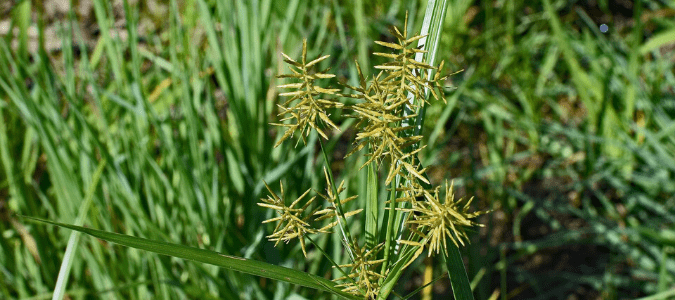
Our yards are often the first impression visitors have of our home. One thing all of us can agree on: Texas weeds are a nuisance, as are these unsightly plants in any other parts of the country. Better understanding how to keep your grass free of weeks starts with knowing common weeds in the state, which are divided into three different categories: broadleaf weeds, sedges and grass-like weeds.
Broadleaf Weeds
These weeds are actually relatively simple to locate in your yard, as they don’t resemble grass and most varieties develop flowers. As their name suggests, these types of weeds have broader leaves than grass.
Common broadleaf weeds homeowners may find in their lawns across the state include:
- Henbit: This is a winter annual weed with greenish-purple stems, purple flowers that develop in the spring and egg-shaped leaves.
- Chickweed: Chickweed is an annual flowering plant that develops white blooms from February until September, but can bloom all year round in favorable conditions. The leaves on this weed are broad, egg-shaped and pointed at the end.
- Prostrate spurge: This summer annual broadleaf weed is low growing with small, oval leaves. This weed commonly has a red dot located in the middle of its leaves, which is its most distinctive feature.
The best way to keep broadleaf weeds out of your lawn is by maintaining a healthy, strong lawn that doesn’t allow these weeds to receive the nutrients they require to grow.
Sedges
While sedges do resemble grasses, they can be differentiated from grass and grass-like weeds because they have three leaves per stem as opposed to the two leaves that grasses develop. Also, you can remember the rhyme about their leaves, “sedges have edges” to help you identify a type of sedge in your yard.
In Texas, homeowners often find these types of sedges in their yards:
- Yellow nutsedge: This kind of sedge grows best in the summer when it gets extremely hot and our lawns may be suffering from the unrelenting high temperatures. The leaves on this weed are greenish-yellow and are waxy to the touch.
- Purple nutsedge: The leaves of purple nutsedge are thicker and stiffer than most grasses. This weed develops dark red to brownish-purple spikelets.
- Globe flatsedge: This flatsedge is often found in lawns that don’t have great drainage. Globe flatsedge has triangular leaves and develops green and globe-like flowers.
Most sedges can be controlled by frequent mowing that removes seed heads and prevents growing. Sedges also love water, so try to cut back on how much you water or how frequently you water if you’re noticing these weeds in your lawn.
Grass-Like Weeds
Grass-like weeds can be very difficult for a homeowner to identify because, as their name indicates, they can often be mistaken as patches of grass. Once a homeowner notices that there is something suspicious going on with the patch of “grass” in their yard, these weeds have often already become established, making them even more difficult to control. Due to the work that must go into identifying this type of weed, we’ll dive into these varieties a little deeper.
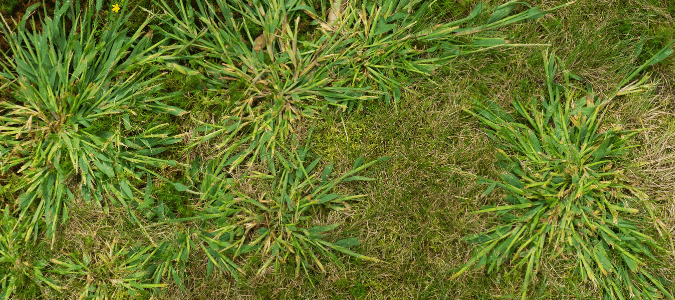
How To Identify Weeds That Look Like Grass
While broadleaf weeds are easy to identify because their leaves are, well, broader than grass, those commonly known as “grassy” weeds are a little more difficult to distinguish.
Grassy Texas weeds have narrow blades that look like grass. They can be just as bright green, if not brighter, as your new spring growth. They can also grow just as quickly, if not quicker, than the turf you hope to cultivate. With a bit of study and a closer inspection, however, you may be able to pinpoint those pesky invaders. If not, calling in a lawn pro is often the best next step to determine whether you have weeds and the best next steps if you do.
Here are a few telltale signs that you’ve got grassy weeds growing in your lawn:
- Most grassy weeds grow in clumps instead of spreading evenly over your lawn
- Seed heads look different on each grassy weed, but typically your grass never gets tall enough to see them, meaning if you mow regularly and still see seed heads, they’re probably weeds
One of the most prevalent weeds often mistaken as grass by Texas home gardeners is crabgrass.
Crabgrass
Crabgrass looks very similar to St. Augustine and is a common St. Augustine grass problem because it can kill that coveted carpet of turf you’re after. This type of weed grows much faster than St. Augustine and other turf grasses, so the earlier you can identify this invasive species, the better.
When crabgrass first sprouts up, its leaves are actually much thinner than St. Augustine. Another way to tell crabgrass from turf is that its stolons grow from a central point instead of just runners over your lawn. If crabgrass tufts are allowed to flourish, they will become large, noticeable clumps growing stolons in all directions in a star-like pattern. At this point, these plants begin suffocating any grass in the area.
Established crabgrass will sprout seed heads with a thin central stalk and even thinner “fingers” lined with rows of tiny white seeds. Once those seeds drop, if you don’t take action, you can expect crabgrass to more broadly cover your lawn the following growing season.
Besides crabgrass, there are two other very common species of weeds in Texas that are also identifiable by differences in growth patterns and seed heads.
Bluegrass Or Poa Annua
Bluegrass, or Poa annua, is the second-most common Texas weed because of its hardiness over summer months. The seed pods are similar to crabgrass, but the “fingers” are thicker and the seeds are dark brown to black. Pre- and post-emergent herbicides are often necessary to target these types of weeds.
Dallisgrass
Dallisgrass, also sometimes called sticky heads, looks very similar to bluegrass, but the green seed pods are thicker, taller and heavier, which makes them droop. You’ll find that dallisgrass doesn’t creep. Instead, its clumped mat simply enlarges over time. The most effective form of control is digging them, as well as all underground rhizomes, out of the ground completely.
Once you’ve identified and controlled the Texas weeds in your yard, the most effective way to stave off new growth is by establishing and properly maintaining what you actually want growing in your yard. If maintaining your grass doesn’t sound like a job you want, you may consider signing up for regular lawn service.
Unfortunately, your lawn isn’t the only place you need to keep an eye out for weeds.
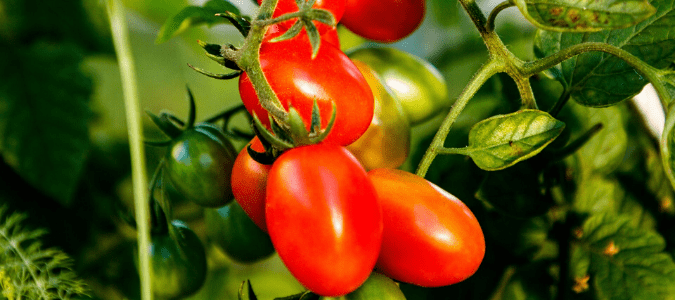
How To Keep Weeds Out Of The Garden
Every inch of your Texas property is more than likely covered in weed seeds. Any outdoor surface where the wind has ever blown probably has weed seeds that are waiting to grow. Fortunately, there are some things you can do to prevent weeds from sprouting in your garden: apply mulch, be cautious when digging holes for new plants, only water your sprouted plants and deadhead weeds.
Because all Texas weeds require sunlight to sprout, only the first couple of inches of soil are conducive to growth. Apply a two-inch layer of mulch to block weeds from getting sunlight, but don’t go any thicker than three inches, as this can prevent the plants you want in your garden from getting the oxygen they require.
Once you have everything in your garden in place, you’ll save yourself a lot of work by trying not to disturb the soil any further. When you have to dig, fill the hole with a plant or cover the area with mulch when you’re finished. Another trick is to use narrow blades and other equipment to sever weed roots or to excavate without disrupting your soil in a bigger way.
Also, watering closer to the plants you want will prevent the plants you don’t want from flourishing. Moreover, planting garden flora as close as guidelines will allow gives them a better chance of choking out unwanted Texas weeds.
Another insider’s tip for at least preventing new growth when you can’t pull the weeds out altogether is to deadhead the seed pods before they drop. Simply clip the pods at the base of every seed stalk and put them in a bag instead of on the ground.
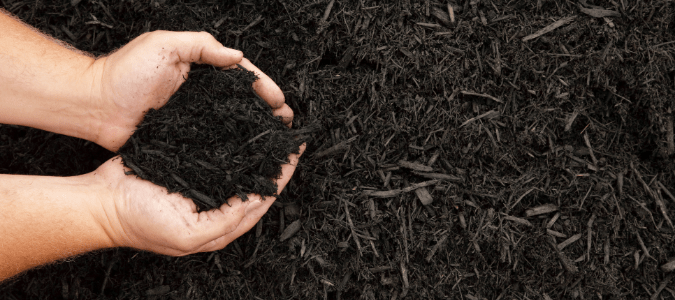
What Can You Do If You Have Weeds In Mulch Areas?
You’ve heard the advice: mulch, mulch, mulch. One of the easiest, most environmentally friendly and effective ways to eliminate weeds is by applying a nice thick layer of mulch to your landscaping. But what if you still see pesky Texas weed sprouts popping up through your carefully laid mulch?
If it’s happening in your garden or landscape, you’re probably asking yourself, “What are these—superweeds?!” Instead, what you should be asking is why are these weeds growing in your mulch, and what can you do about them?
Add More Mulch
In order for mulch to be an effective barrier, it has to be thick enough to block all light. That means your mulch layer has to be between 2 to 3 inches thick before you can begin to consider it as a preventative measure against hardy Texas weeds. If your mulch isn’t laid on thick enough there’s an easy fix: pull the weed sprouts and add more mulch.
Just remember that anything thicker than a three-inch layer will prevent the growth of the plants you actually do want.
Apply Pre-Emergent
If you have a history of weeds in your mulch and are tired of hand-pulling weeds all year long, there’s another solution. Before adding new mulch, consider applying a pre-emergent base layer. Simply apply your products as directed, which it will create a super-thin layer that can’t be penetrated by Texas weed sprouts. Add mulch carefully to prevent breaking the pre-emergent barrier.
Hire A Professional
A professional lawn service can get you on a good weed-control rotation. Once you’ve got good growth established, you can take over the reins of regular maintenance or leave the dull parts of landscaping maintenance to the experts so you can save your time and have a consistently beautiful yard. An added benefit is that expert advice can also help in other areas, such as learning more about how to keep your lawn green in summer heat.
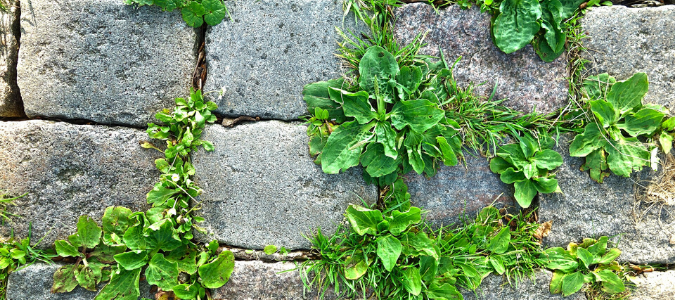
Discouraging The Growth Of Weeds Between Pavers
This is a more straightforward challenge than mulched areas simply because there isn’t as much room for growth between landscape pavers. Weeds between pavers, for most homeowners, are more of an annoyance than a menace. Besides the obvious regular hand-pulling, here are a few ways to stop Texas weeds from taking over your paved pathways.
Proper Path Installation
Using the right kind of sand when creating that initial leveled base for your patio stones will prevent weeds for a long time. For previously installed paths, you can also pack sand in between the stones to help stifle plant growth.
Checking Your Walkway’s Slope
Remember that weeds need cool, damp soil to thrive. If rainwater doesn’t run off the walkway, debris can build up, making new beds for weed seeds to settle in.
Spraying With White Vinegar
Pour some white vinegar into a spray bottle and give the weeds between your pavers a couple of sprays. After a few hours, hose down your pavers. The white vinegar shouldn’t stain your pavers, but if you’re concerned about any possible damage, you can always consult with a professional.
Pressure Wash Your Pavers Each Season
The level of pressure in a pressure washer is high enough that it should clear out weeds, sprouts, seeds and soil altogether. Note, however, that it may also remove any packed sand, which can help prevent new sprouts. For this reason, we recommend replacement sand afterward.
Sweeping Paved Paths Regularly
Less surface debris makes for less room to grow. Sweeping your pavers can disrupt any weed seeds that have settled between the cracks from becoming established.
Weeds can be extremely difficult to control, as they can easily sprout when life gets busy and other priorities mean that you aren’t paying as much attention to your yard care schedule. By having a professional maintain your yard, you can have peace of mind knowing your lawn is growing strong and healthy and that weeds are kept at bay.
ABC Can Help You Prevent Texas Weeds
The lawn care specialists at ABC Home & Commercial Services are well-versed in the different types of weeds in Texas and also have a thorough understanding of how to care for your grass and plants. While having a healthy, strong grass is the best way to prevent the growth of any unwanted plants, our lawn experts can help you with a lawn care schedule that will give your lawn the perfect amount of mulch, water, mowing and fertilizing, so you don’t have to worry about weeds or other common lawn problems.
